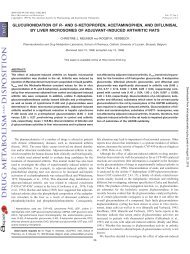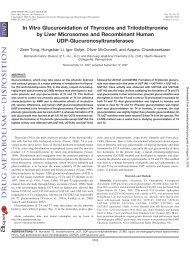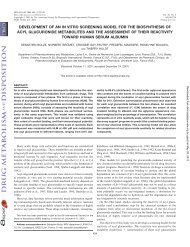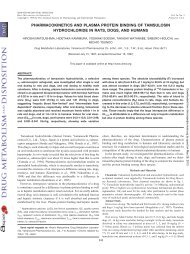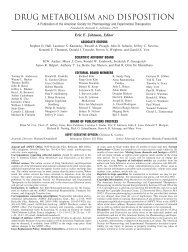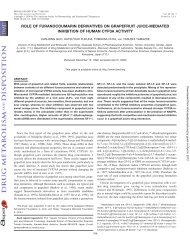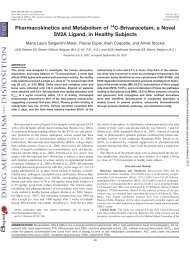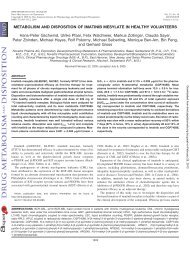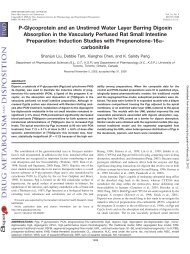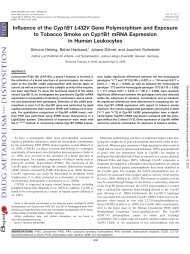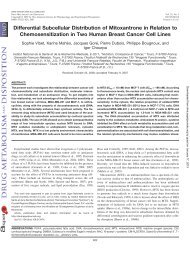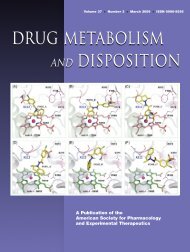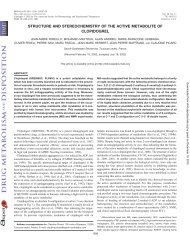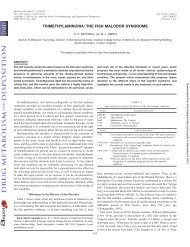DMD #048264 1 Discovery and Characterization of Novel, Potent ...
DMD #048264 1 Discovery and Characterization of Novel, Potent ...
DMD #048264 1 Discovery and Characterization of Novel, Potent ...
You also want an ePaper? Increase the reach of your titles
YUMPU automatically turns print PDFs into web optimized ePapers that Google loves.
<strong>DMD</strong> <strong>#048264</strong><br />
<strong>and</strong> flunarizine are not substrate <strong>of</strong> CYP2J2. It is also noted that after incubation <strong>of</strong><br />
telmisartan <strong>and</strong> flunarizine in HLM for 30 minutes, the percentage remaining <strong>of</strong><br />
telmisartan <strong>and</strong> flunarizine was 97.7% <strong>and</strong> 83.8%, respectively.<br />
Telmisartan <strong>and</strong> Flunarizine Show No Time-dependent Inhibition toward<br />
CYP2J2. The time-dependent inhibition toward CYP2J2 <strong>of</strong> the most potent inhibitors,<br />
telmisartan <strong>and</strong> flunarizine, was also investigated. After pre-incubation <strong>of</strong> the inhibitor<br />
with CYP2J2 protein for 30 minutes in the presence <strong>and</strong> absence <strong>of</strong> NADPH, the IC50<br />
values <strong>of</strong> CYP2J2 inhibition were then measured in both cases. The IC50 shift was<br />
calculated as IC50 in the absence <strong>of</strong> NADPH over IC50 in the presence <strong>of</strong> NADPH. As<br />
shown in Figure 3, telmisartan <strong>and</strong> flunarizine displayed marginal IC50 shift <strong>of</strong> 1.0 <strong>and</strong><br />
1.3, respectively, both <strong>of</strong> which are smaller than the TDI IC50 shift threshold <strong>of</strong> 1.5<br />
(Berry <strong>and</strong> Zhao, 2008), indicating none <strong>of</strong> them are time-dependent inhibitor <strong>of</strong><br />
CYP2J2.<br />
Telmisartan <strong>and</strong> Flunarizine Exhibit Distinctive CYP2J2 Inhibition Kinetics.<br />
Detailed inhibition kinetics studies were carried out for both telmisartan <strong>and</strong> flunarizine<br />
<strong>and</strong> the results are shown in Figure 4. The non-linear regression curves <strong>of</strong> velocity versus<br />
substrate concentration <strong>and</strong> the Dixon plots <strong>of</strong> the reciprocal <strong>of</strong> velocity (1/v) versus<br />
inhibitor concentration were drawn for the substrate astemizole at 0.05, 0.1, 0.15, 0.3, <strong>and</strong><br />
0.45 μM, for telmisartan at 0, 0.2, 0.5, <strong>and</strong> 2 μM, <strong>and</strong> for flunarizine at 0, 0.2, 1, <strong>and</strong> 5<br />
μM, respectively. Visual inspection <strong>of</strong> the Dixon plots (Figure 4, panels C <strong>and</strong> D <strong>and</strong><br />
insets) suggests that both telmisartan <strong>and</strong> flunarizine could be a competitive or mixed<br />
type inhibitor for CYP2J2 with a similar Ki value <strong>of</strong> about 0.1 μM. Furthermore, as<br />
shown in the slope <strong>of</strong> Dixon plot versus reciprocal <strong>of</strong> substrate concentration (1/[S]) plots<br />
(Figure 4, panels E <strong>and</strong> F), telmisartan is indicated to be a mixed type inhibitor (i.e., the<br />
18



